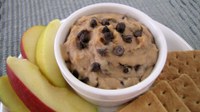Prairie Fare: Adults Can Learn Lessons From School Lunch Research
(Click an image below to view a high-resolution image that can be downloaded)
By Julie Garden-Robinson, Food and Nutrition Specialist
NDSU Extension Service
“Mom, I am almost out of lunch money,” my 12-year-old daughter announced one day. She was holding my purse.
Even though I was in the middle of doing something, I knew she would be standing right next to me until she had her funding. She gets her patience from me, I guess.
“Yes, I will write a check for you right away,” I replied. I needed a break, so I clicked the pen and began writing the check. While doing so, I glanced up and asked her a few questions.
“Are you having some fruit every day at school?” I asked.
She nodded. Fruit is sweet, so that’s an easy pick for her. She has a bit of a sweet tooth.
“Are you eating vegetables every day?” I asked. Veggies are a tougher sell.
She was tapping her foot impatiently, so I tried to secure eye contact. As with most parents, I possess special fib-detecting abilities.
“Yes, I eat vegetables at school. I go to the salad bar,” she said earnestly.
“Go for the brightly colored vegetables such as carrots or spinach instead of iceberg lettuce, if that is the choice,” I added as I tore the check from my checkbook.
She zipped out of the room. I really was not going to deliver a full-fledged lecture on the nutritional merits of colorful produce. She probably could recite it for me, anyway.
Most kids shortchange themselves on fruits and vegetables, so the National School Lunch Program has placed a greater emphasis on helping kids meet the daily dietary goals for fruits and vegetables. Some schools also have breakfast and snack programs that provide fruits and vegetables.
Most adults also do not meet daily goals for fruits and vegetables. As with older kids, most adults need about 4 1/2 cups of fruits and vegetables daily. Our nutritional needs differ, depending on our gender, age and level of exercise.
We all should aim to fill about half of our plates with a variety of fruits and vegetables. Numerous studies have shown that eating plenty of fruits and vegetables can help protect us from chronic diseases, including several types of cancer, throughout our lifetime. Fruits and vegetables also are low in calories, and many of them are high in vitamins A and C.
Cornell University has published the results of research showing that many factors affect the choices children make during school lunch. We adults also can learn from these research-based lessons.
For example, if elementary school students are allowed to have a recess break before lunch, they are more likely to select fruits and vegetables. To be exact, 45 percent more children selected fruits and vegetables when recess came before lunch.
Unfortunately, adults do not get recess. You might want to take a walk before lunch to build your appetite for a healthful lunch break.
The order of foods on a buffet line at a cafeteria influences the choices we make. Whatever is served first on the line is most likely to be selected. Arranging food attractively and cutting the fruit makes it more likely to be selected and eaten.
Another study by Cornell researchers showed that the percentage of students who ate at least half their fruit increased by 70 percent if the fruit was cut instead of served whole.
The same rule applies to adults. If you have “snack bags” filled with ready-to-eat broccoli, carrots and cauliflower florets or orange slices, you are more likely to grab a healthful, quick snack. Frankly, who wants to get out a cutting board and knife when you are hungry? We tend to grab what is available.
But what about chocolate milk at school? Although I don’t have proof, I suspect that my daughter chooses chocolate milk most of the time. I don’t mind. She has white milk at home, and she still gets the calcium, protein and all the other nutrients from the chocolate version.
When 11 Oregon schools banned chocolate milk, the children threw 29 percent more milk away and 7 percent of students stopped eating school lunch entirely.
We all need calcium to maintain our bones, and milk and yogurt are convenient ways for us to meet our calcium needs. If you cannot or do not consume dairy for various reasons, be sure you are reading Nutrition Facts labels to ensure that you are making food choices that provide adequate calcium. You may need a dietary supplement.
Sometimes dips are provided to encourage children to eat fruits or vegetables. However, condiments such as ranch dressing and ketchup can be quite high in sodium. For a snack that packs some protein and fiber, how about making low-sodium, nutrient-rich hummus?
Hummus is made from chickpeas, which can count as a protein food or a vegetable. The same rule holds true with any legume. For example, you can count kidney beans as a vegetable or a protein food.
Hummus usually is made “savory” with tahini (sesame seed paste), lemon juice, garlic and spices, but here’s a version suitable for a dessert dip served with crisp apple slices or graham crackers. See “Hummus, Roasted Chickpeas and More” (available at https://www.ag.ndsu.edu/pubs/yf/foods/fn1739.pdf) for a savory hummus recipe and a method to make your own crunchy roasted chickpeas.
Dessert Hummus
1 (15-ounce) can chickpeas, drained and rinsed
1/4 c. creamy peanut butter
1/4 c. maple syrup
1/2 Tbsp. vanilla extract
1/4 c. mini semisweet chocolate chips
Blend together the chickpeas, peanut butter, maple syrup and vanilla extract by hand or in a blender. Stir chocolate chips into mixture. Serve with apple slices or graham crackers.
Makes 12 snack servings. Each serving has 95 calories, 4 grams (g) fat, 3 g protein, 14 g carbohydrate, 2.5 g fiber and 38 milligrams sodium.
(Julie Garden-Robinson, Ph.D., R.D., L.R.D., is a North Dakota State University Extension Service food and nutrition specialist and professor in the Department of Health, Nutrition and Exercise Sciences.)
NDSU Agriculture Communication - Jan. 28, 2016
| Source: | Julie Garden-Robinson, (701) 231-7187, julie.garden-robinson@ndsu.edu |
|---|---|
| Editor: | Ellen Crawford, (701) 231-5391, ellen.crawford@ndsu.edu |



